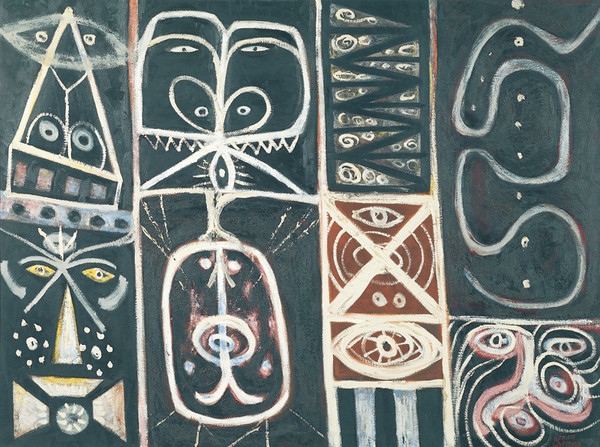Signs & Symbols
28 Jun - 28 Oct 2012

Adolph Gottlieb (1903–1974)
Vigil, 1948
Oil on canvas
36 × 48 in. (91.4 × 121.9 cm).
Whitney Museum of American Art, New York; purchase 49.2. Art © Adolph and Esther Gottlieb Foundation / Licensed by VAGA, New York, NY
Vigil, 1948
Oil on canvas
36 × 48 in. (91.4 × 121.9 cm).
Whitney Museum of American Art, New York; purchase 49.2. Art © Adolph and Esther Gottlieb Foundation / Licensed by VAGA, New York, NY
SIGNS & SYMBOLS
28 June – 28 October 2012
Drawn from the Museum’s deep holdings of paintings, sculpture, drawings, prints, and photographs, Signs & Symbols sheds new light on the development of American abstraction during the critical postwar period of the mid-1940s to the end of the 1950s. Many artists active in this period who are often overlooked—Will Barnet, Forrest Bess, Charles Seliger, and Mark Tobey, among others—developed abstract work that remains distinct from many of the concerns associated with the canonized Abstract Expressionists, including large-scale canvases and gestural brushwork. Instead, the exhibition presents a more nuanced narrative, focused on the figurative and calligraphic “signs and symbols” present in much of the highly controlled work from this period and included in this show. In many cases, this work drew inspiration from specifically American sources and sought to foster a national aesthetic distinct from European Surrealism and Cubism. These investigations formed an important foundation for a future generation of artists—including Jasper Johns and Roy Lichtenstein—who later incorporated highly individualized systems of signs into their own work while embracing distinctly American subject matter.
Signs & Symbols is organized by Donna De Salvo, chief curator and deputy director for programs.
28 June – 28 October 2012
Drawn from the Museum’s deep holdings of paintings, sculpture, drawings, prints, and photographs, Signs & Symbols sheds new light on the development of American abstraction during the critical postwar period of the mid-1940s to the end of the 1950s. Many artists active in this period who are often overlooked—Will Barnet, Forrest Bess, Charles Seliger, and Mark Tobey, among others—developed abstract work that remains distinct from many of the concerns associated with the canonized Abstract Expressionists, including large-scale canvases and gestural brushwork. Instead, the exhibition presents a more nuanced narrative, focused on the figurative and calligraphic “signs and symbols” present in much of the highly controlled work from this period and included in this show. In many cases, this work drew inspiration from specifically American sources and sought to foster a national aesthetic distinct from European Surrealism and Cubism. These investigations formed an important foundation for a future generation of artists—including Jasper Johns and Roy Lichtenstein—who later incorporated highly individualized systems of signs into their own work while embracing distinctly American subject matter.
Signs & Symbols is organized by Donna De Salvo, chief curator and deputy director for programs.
